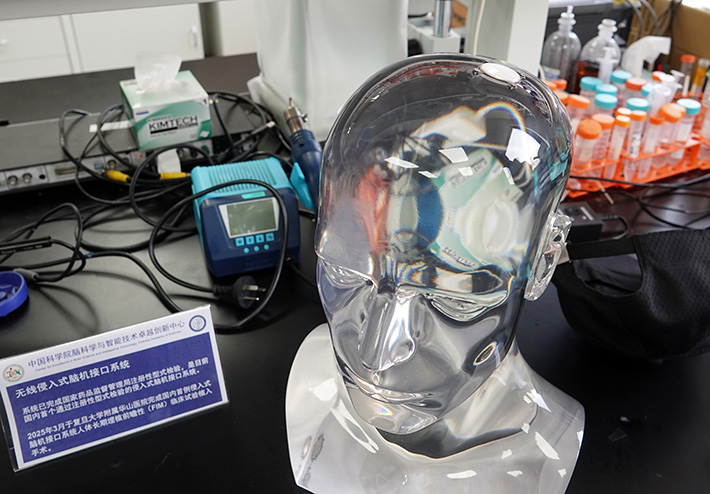|
||||||||||
| Home Top News Economy/Tech Culture/Sports China in Foreign Eyes Green Development Videos Intangible Cultural Heritages |
|
||||||||||
| Home Top News Economy/Tech Culture/Sports China in Foreign Eyes Green Development Videos Intangible Cultural Heritages |
| ChinAfrica |
| Wired Minds |
| Brain-machine interface could give patients back their speech, sight or mobility |
| By GE LIJUN | VOL.17 August 2025 ·2025-07-25 |

Demonstration of an invasive brain-machine interface in Shanghai on 3 June (CNS)
In The Matrix, the protagonist connects to the Matrix to navigate between the real and virtual worlds. In Ghost in the Shell, the brain-machine interface becomes an important bridge between man and machine. These science fiction works show a technology that was as fascinating as it was inaccessible - until recently. This interface, which for a long time only existed in fantasy, is now appearing in the real world.
The brain-machine interface, or BMI, is a revolutionary technology for human-machine interaction. It captures neural signals, interprets them and then translates them into instructions so that the brain can communicate directly with external devices. Thanks to amazing advances in artificial intelligence, flexible materials and biosensors, this technological dream is now within reach.
There are three approaches depending on the level of intervention: non-invasive, semi-invasive and invasive. The latter two, used in medicine, require surgery and intervene directly in neural tissue, offering a degree of precision that raises hopes of restoring movement, sight or hearing in severely disabled patients.
Non-invasive devices are also making progress, particularly in the field of rehabilitation. They are showing promise for helping people suffering from cognitive or motor disorders, such as Alzheimer’s disease. And the technology is already starting to spread to other areas, ranging from education and security to video games.
The year 2025 marks a significant acceleration in the development of the BMI. In January, Elon Musk announced on social media that his company Neuralink had successfully implanted a third device in a patient, with around 20 more operations planned by the end of the year.
In China, since the beginning of the year, several important milestones have been achieved. The locally developed semi-invasive Beinao-1 device has been trialled on five patients in three hospitals. Some paralysed patients have regained their movements through thought, and ALS patients have been able to communicate again.
In June, the first clinical trial of an invasive BMI in China took place in Shanghai. A patient who had lost all four limbs was given a brain implant. Within weeks, he was able to play chess and racing games on a computer using only his thoughts. This makes China the second country after the US to achieve this milestone.
At the moment, reality is still a long way from the futuristic worlds of cinema. But there is every reason to believe that the BMI will profoundly change the field of medical rehabilitation within five years, benefiting millions of people.
| About Us | Contact Us | Advertise with Us | Subscribe |
| Copyright Beijing Review All rights reserved 京ICP备08005356号-5 京公网安备110102005860号 |